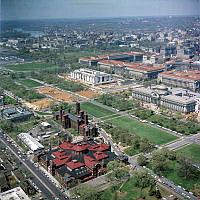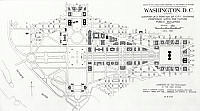McMillan 1902 plan of Washington, D.C.
This plan for the design of the National Mall was created by architects Daniel H. Burnham and Charles F. McKim, landscape architect Frederick Law Olmsted, Jr., and sculptor Augustus Saint-Gaudens in 1901 during Theodore Roosevelt's presidency. The Senate Park Commission undertook a project to design and redevelop the National Mall, eventually publishing the 1902 McMillan Plan, named for James McMillan, the Michigan senator who headed the commission. The McMillan Plan called for the construction of a Mall with a long expanse of grass 300 feet in width, major memorials at the southern and western ends of the Mall's axes, and a series of museums along the east-west axis.


